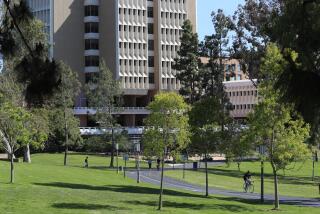Stem Cells Seen as Tool to Test Cardiac Drugs
- Share via
The scientist who first isolated human embryonic stem cells in his laboratory now hopes to profit from the discovery.
Even as a bruising debate unfolds in Washington over federal funding for stem cell research, Jamie Thomson and two colleagues at the University of Wisconsin-Madison have formed a company to test new drugs on heart cells they plan to develop from the undifferentiated master cells.
Heart cells don’t survive long or reproduce outside the body, so scientists are now limited to testing the effects of experimental drugs on the heart in live animals and people. Heart cells derived from stem cells are thought to be hardier and will allow drug tests on the heart to occur in a petri dish.
Thomson, who first isolated human embryonic stem cells in 1998, said the new company, Cellular Dynamics International, could show that Wisconsin is still a leader in the field as it faces stiff competition from other states.
He and his partners will have their work cut out for them.
None of the handful of companies attempting to turn stem cells into profits has done anything but lose money. Not a single product derived from human embryonic stem cells has been tested on people.
Geron Inc., the Menlo Park, Calif., industry leader, said it hoped to test an experimental stem cell therapy to treat spinal cord injuries sometime next year. Geron lost $80 million last year.
Stem cells are created in the first days after conception and go on to form the body’s tissues and cells. Researchers hope to use stem cells to grow replacements for faulty body parts and develop therapies for a variety of diseases.
But many social conservatives oppose the research because days-old embryos -- usually donated by fertility clinics -- are destroyed in the process. President Bush has severely limited the amount of federal funding that stem cell researchers may receive. Bush also has threatened to veto a bill, already approved by the House this week, that would loosen federal restrictions.
What’s more, California’s new stem cell agency is expected to make the state the leader in the field, in part because it will distribute $3 billion in research funds. Still, some see Thomson’s decision to locate the company near his Madison lab as a sign he’s staying put in Wisconsin and resisting California’s siren song of funding.
“Everybody’s going to be watching, and the fact that Dr. Thomson is doing this makes it a little higher profile,” said Michael Werner, chief of policy for the Biotechnology Industry Organization, which represents more than 1,000 biotech companies. “People are always looking for ways to simplify and streamline the drug discovery and development process. This could be a way to do that.”
Thomson and another company founder, professor Timothy Kamp, said they had figured out how to coax embryonic stem cells to turn into human heart cells that actually beat. The company plans to sell the heart cells to biotech and pharmaceutical companies that want to test the safety and effectiveness of potential drugs. Researchers will be able to quickly see how the heart cells react to different chemical substances.
Whereas much of the focus on human embryonic stem cell research has been on the potential to use the cells to cure difficult diseases, this testing will allow scientists to better understand the biology of how cells work.
Researchers often use heart cells from mice to test drugs, but their heart rate is 600 beats a minute compared with 60 to 100 beats for human hearts, Kamp said.
Cellular Dynamics will at first develop tests made from kidney cells tweaked to mimic heart cells, a technique invented by company co-founder Craig January. Company executives would not say when they expected to begin working with actual heart cells developed from stem cells.
David Prentice of the Family Research Council, a conservative advocacy group, said he was skeptical that the firm’s research would be groundbreaking.
“It will be interesting to see how fast this actually moves and whether they get it into practice,” he said. “It’s a baby step for embryonic stem cell researchers, but they are still a long way from making good on their promises.”






